Intel's Pentium M on the Desktop - A Viable Alternative?
by Anand Lal Shimpi on February 7, 2005 4:00 PM EST- Posted in
- CPUs
Workstation Applications
Visual Studio 6
Carried over from our previous CPU reviews, we continue to use Visual Studio 6 for a quick compile test. We are still using the Quake 3 source code as our test and measure compile time in seconds.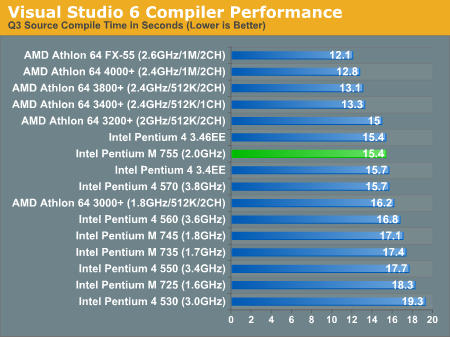
The Pentium M is very competitive with the Pentium 4 in our compiler test, but still not enough to compete with the Athlon 64.
SPECviewperf 8
For our next set of professional application benchmarks, we turn to SPECviewperf 8. SPECviewperf is a collection of application traces taken from some of the most popular professional applications, and compiled together in a single set of benchmarks used to estimate performance in the various applications that the benchmark is used to model. With version 8, SPEC has significantly improved the quality of the benchmark, making it even more of a real world indicator of performance.We have included SPEC's official description of each one of the 8 tests in the suite.
As you can guess, with the majority of performance in 3D workstation applications being determined by floating point performance and memory bandwidth, the Pentium M doesn't fare too well:
3dsmax Viewset (3dsmax-03)
"The 3dsmax-03 viewset was created from traces of the graphics workload generated by 3ds max 3.1. To ensure a common comparison point, the OpenGL plug-in driver from Discreet was used during tracing.
The models for this viewset came from the SPECapc 3ds max 3.1 benchmark. Each model was measured with two different lighting models to reflect a range of potential 3ds max users. The high-complexity model uses five to seven positional lights as defined by the SPECapc benchmark and reflects how a high-end user would work with 3ds max. The medium-complexity lighting models use two positional lights, a more common lighting environment.
The viewset is based on a trace of the running application and includes all the state changes found during normal 3ds max operation. Immediate-mode OpenGL calls are used to transfer data to the graphics subsystem."
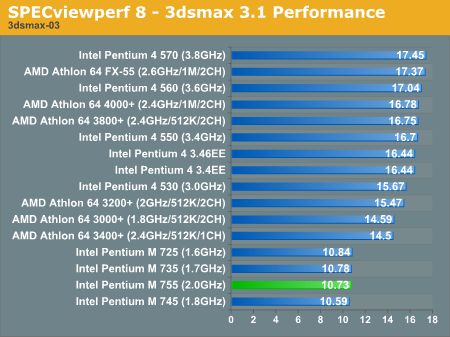
CATIA Viewset (catia-01)
"The catia-01 viewset was created from traces of the graphics workload generated by the CATIATM V5R12 application from Dassault Systems.
Three models are measured using various modes in CATIA. Phil Harris of LionHeart Solutions, developer of CATBench2003, supplied SPEC/GPC with the models used to measure the CATIA application. The models are courtesy of CATBench2003 and CATIA Community.
The car model contains more than two million points. SPECviewperf replicates the geometry represented by the smaller engine block and submarine models to increase complexity and decrease frame rates. After replication, these models contain 1.2 million vertices (engine block) and 1.8 million vertices (submarine).
State changes as made by the application are included throughout the rendering of the model, including matrix, material, light and line-stipple changes. All state changes are derived from a trace of the running application. The state changes put considerably more stress on graphics subsystems than the simple geometry dumps found in older SPECviewperf viewsets.
Mirroring the application, draw arrays are used for some tests and immediate mode used for others."
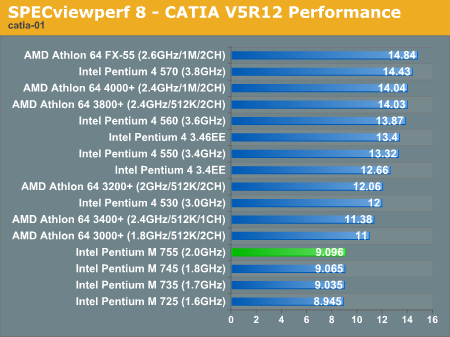
Lightscape Viewset (light-07)
"The light-07 viewset was created from traces of the graphics workload generated by the Lightscape Visualization System from Discreet Logic. Lightscape combines proprietary radiosity algorithms with a physically based lighting interface.
The most significant feature of Lightscape is its ability to simulate global illumination effects accurately by precalculating the diffuse energy distribution in an environment and storing the lighting distribution as part of the 3D model. The resulting lighting "mesh" can then be rapidly displayed."
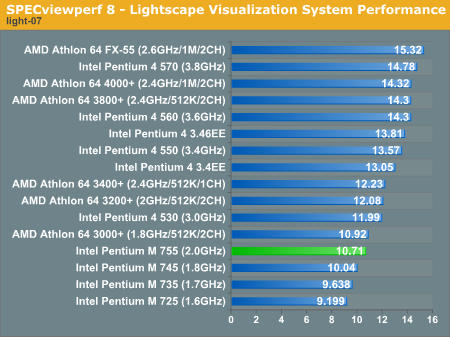
Maya Viewset (maya-01)
"The maya-01 viewset was created from traces of the graphics workload generated by the Maya V5 application from Alias.
The models used in the tests were contributed by artists at NVIDIA. Various modes in the Maya application are measured.
State changes as made by the application are included throughout the rendering of the model, including matrix, material, light and line-stipple changes. All state changes are derived from a trace of the running application. The state changes put considerably more stress on graphics subsystems than the simple geometry dumps found in older viewsets.
As in the Maya V5 application, array element is used to transfer data through the OpenGL API."
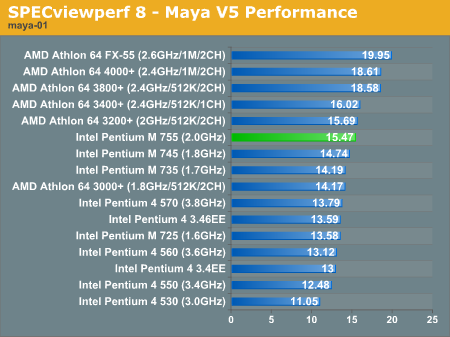
Pro/ENGINEER (proe-03)
"The proe-03 viewset was created from traces of the graphics workload generated by the Pro/ENGINEER 2001TM application from PTC.
Two models and three rendering modes are measured during the test. PTC contributed the models to SPEC for use in measurement of the Pro/ENGINEER application. The first of the models, the PTC World Car, represents a large-model workload composed of 3.9 to 5.9 million vertices. This model is measured in shaded, hidden-line removal, and wireframe modes. The wireframe workloads are measured both in normal and antialiased mode. The second model is a copier. It is a medium-sized model made up of 485,000 to 1.6 million vertices. Shaded and hidden-line-removal modes were measured for this model.
This viewset includes state changes as made by the application throughout the rendering of the model, including matrix, material, light and line-stipple changes. The PTC World Car shaded frames include more than 100MB of state and vertex information per frame. All state changes are derived from a trace of the running application. The state changes put considerably more stress on graphics subsystems than the simple geometry dumps found in older viewsets.
Mirroring the application, draw arrays are used for the shaded tests and immediate mode is used for the wireframe. The gradient background used by the Pro/E application is also included to better model the application workload."

SolidWorks Viewset (sw-01)
"The sw-01 viewset was created from traces of the graphics workload generated by the Solidworks 2004 application from Dassault Systemes.
The model and workloads used were contributed by Solidworks as part of the SPECapc for SolidWorks 2004 benchmark.
State changes as made by the application are included throughout the rendering of the model, including matrix, material, light and line-stipple changes. All state changes are derived from a trace of the running application. The state changes put considerably more stress on graphics subsystems than the simple geometry dumps found in older viewsets.
Mirroring the application, draw arrays are used for some tests and immediate mode used for others."

Unigraphics (ugs-04)
"The ugs-04 viewset was created from traces of the graphics workload generated by Unigraphics V17.
The engine model used was taken from the SPECapc for Unigraphics V17 application benchmark. Three rendering modes are measured -- shaded, shaded with transparency, and wireframe. The wireframe workloads are measured both in normal and anti-alised mode. All tests are repeated twice, rotating once in the center of the screen and then moving about the frame to measure clipping performance.
The viewset is based on a trace of the running application and includes all the state changes found during normal Unigraphics operation. As with the application, OpenGL display lists are used to transfer data to the graphics subsystem. Thousands of display lists of varying sizes go into generating each frame of the model.
To increase model size and complexity, SPECviewperf 8.0 replicates the model two times more than the previous ugs-03 test."
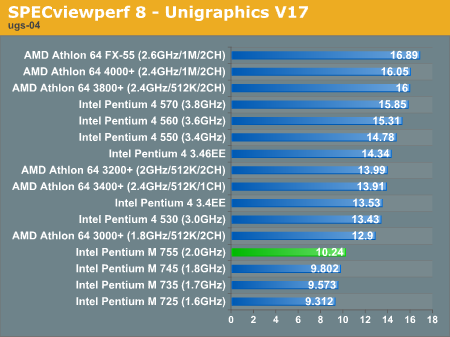










77 Comments
View All Comments
CSMR - Monday, February 7, 2005 - link
The fact is it's an excellent processor for business use (speed, quietness, reliability) and multimedia use (quietness). Anandtech is full of gamers; but there is no denying that using a computer as a media centre is becoming a big thing, or that low-power, quiet operation is necessary. High motherboard prices are because the desktop PM motherboard market is very small. There was a comment in the review that the PM architecture doesn't scale well. I am sure that is so; but what processors do scale well? It's because they don't that everyone is about to go dual-core.bobsmith1492 - Monday, February 7, 2005 - link
Thanks #12 :PZebo - Monday, February 7, 2005 - link
I myself have been guilty of hyping dothan after seeing GAMEPCs "opimistic" review. This should quell that.:DZebo - Monday, February 7, 2005 - link
Anand best review I've read here, thanks a lot, nice to see you scribing again..:)Seems again, like the tech report review, with a comprehensive test suite such as this one dothan has some collosal performance flaws, and simply can't match up the A64 across board. It looses 30 out of 41 benches at same speed, some huge. 2.0 vs 2.0..
I posted in CPU forum how turion/lancaster will be 25W.. could this be the end of DOTHANS laptop dominace?
Brian23 - Monday, February 7, 2005 - link
I agree with #10.bobsmith1492 - Monday, February 7, 2005 - link
Sorry; first time commenting. I couldn't remember my login name before.Anyway, my laptop OCs better than that. Granted, it's a 1.7 to begin with, but the FSB will do 125 easily, with the same ram increase to boot - 420 MHz, with processor at 2.125. It will do a tad bit more, but that's enough for a laptop I'd say.
bobsmith1492 - Monday, February 7, 2005 - link
testKalessian - Monday, February 7, 2005 - link
#6, Oh yeah? Well, give a P4/A64 an SXGP(Super eXtremely Good Performance) setting and stay out of ITS way!Yawn, right now the P-M doesn't impress me at all. Let a CPU built for mobile systems stay in mobile systems until it gets rebuilt for desktops properly.
Great review, learned a ton :)
GnomeCop - Monday, February 7, 2005 - link
I have a 2.0ghz dothan system, I upgraded from an old 533mhz fsb p4.The speed for my work and games are just fine. I have a leadtek GF6800ultra in my system and its the only thing I have to worry about cooling.
CPU is passively cooled and the system is expremely quiet running on a 359watt psu. By the time I need to upgrade, I will be buying a whole new cpu/mobo/everything anyways.
ksherman - Monday, February 7, 2005 - link
seems like an a really good processor for buisness machines, given the L1 cahe speeds... and not much else (snas uber low power consumption)